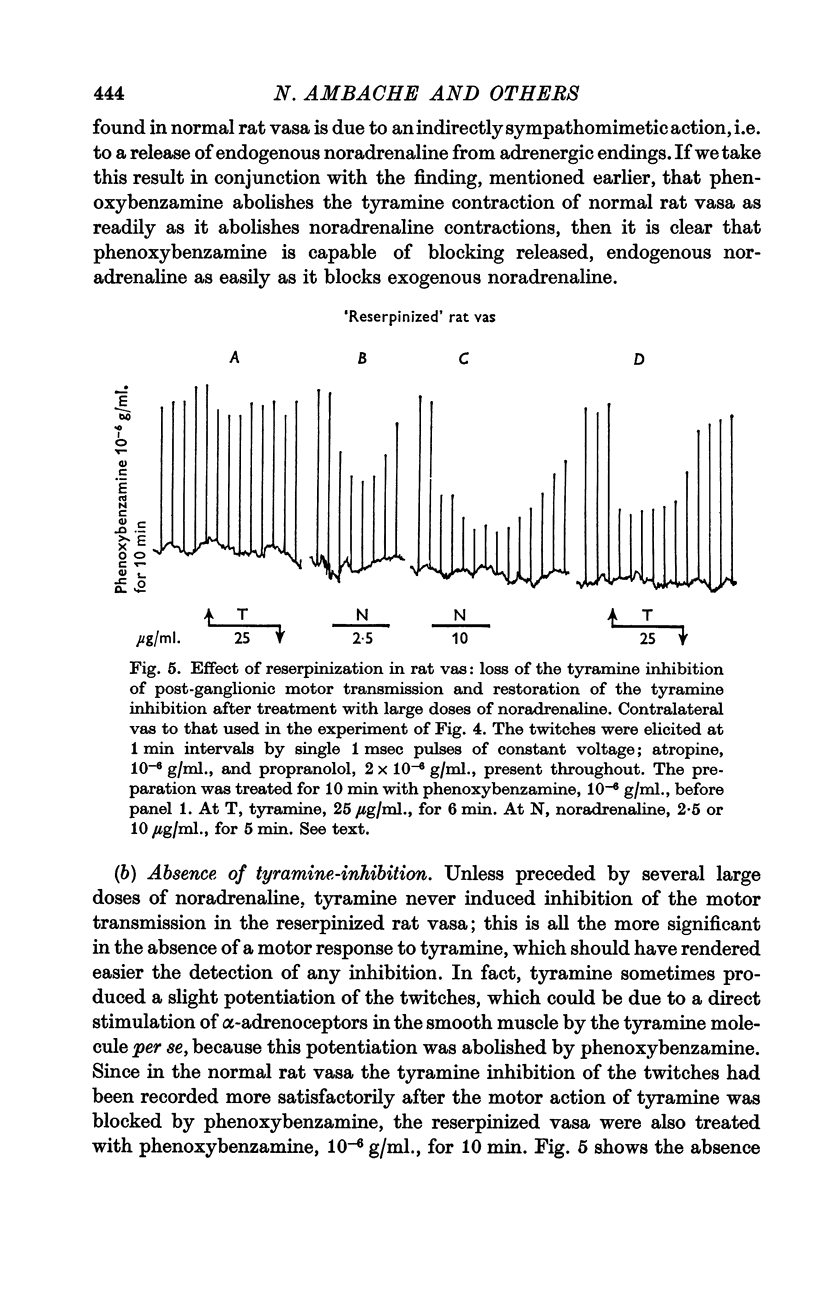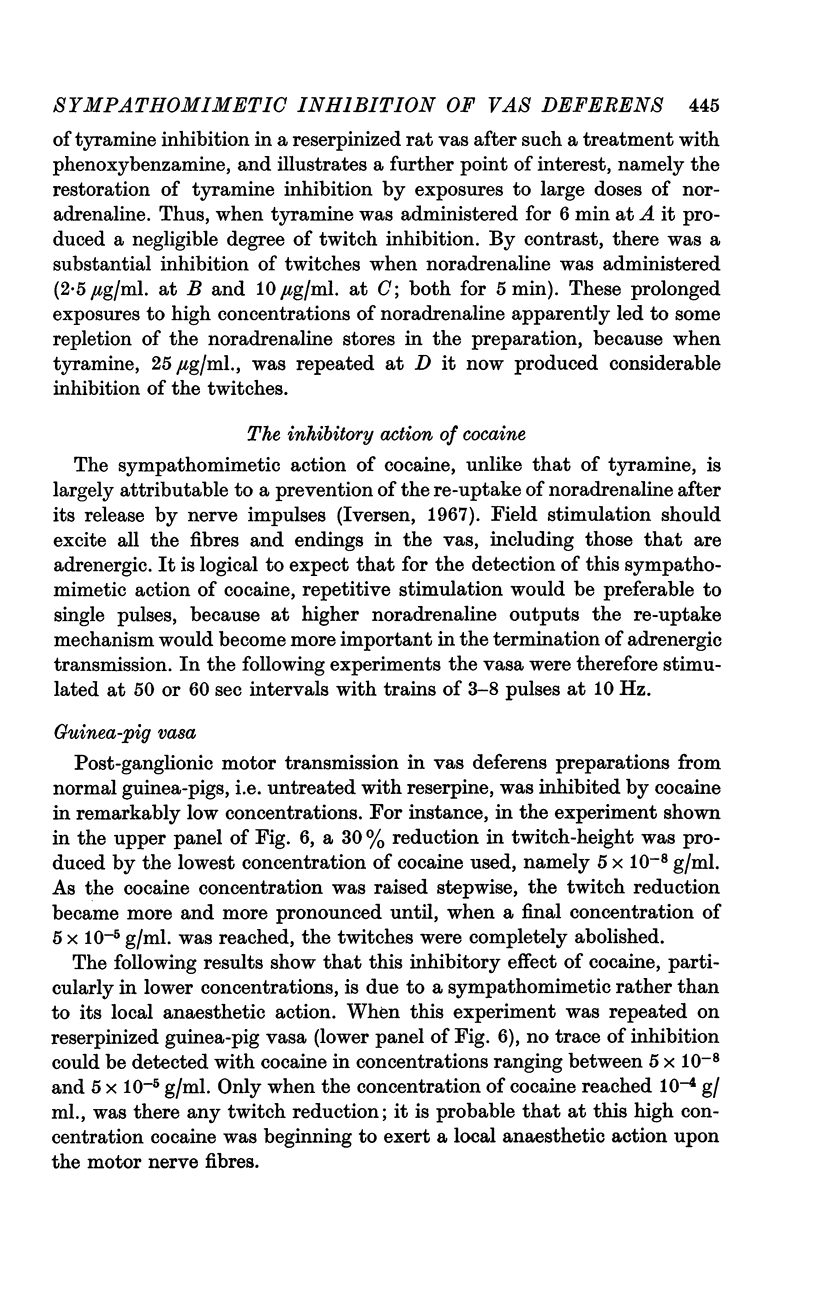Abstract
1. Using field stimulation with short trains of pulses (< 10 per train), the post-ganglionic motor transmission in the mammalian vas deferens has been further analysed pharmacologically.
2. In preparations taken from guinea-pigs, rats and rabbits the effects of the indirectly sympathomimetic drugs, tyramine and cocaine, could be explained entirely on the basis of the actions of released, endogenous noradrenaline.
3. Tyramine produced a contraction in vasa taken from normal rats but not from normal guinea-pigs. The tyramine contraction was due to release of endogenous noradrenaline because it was not seen in preparations taken from reserpinized rats and because it was abolished in normal vasa by phenoxybenzamine or phentolamine, thus denying the supposed inaccessibility, to α-blockers, of the motor α-adrenoceptors activated by endogenous noradrenaline.
4. Phenoxybenzamine or phentolamine failed to block post-ganglionic motor transmission in rat and in guinea-pig vasa.
5. Tyramine strongly inhibited motor transmission in vasa taken from normal but not from reserpinized guinea-pigs.
6. Tyramine produced inhibition of motor transmission in phenoxybenzamine-treated preparations taken from normal but not from reserpinized rats.
7. Cocaine inhibited motor transmission in guinea-pig and in rat vasa. This effect was not due to a local anaesthetic or to a smooth-muscle depressant action because it did not occur in preparations taken from reserpinized animals.
8. The inhibitory effect of tyramine or cocaine was not abolished by β-adrenoceptor blockade with propranolol.
9. Whereas reserpinization abolished the tyramine- and cocaine-inhibitions, it did not affect the inhibitory actions of noradrenaline or of PGE2.
10. Indomethacin and sodium meclofenamate, which suppress prostaglandin synthesis, did not affect the twitch-inhibiting actions of noradrenaline, tyramine or cocaine.
11. These results provide further support for the conclusion that post-ganglionic motor transmission to the vas deferens is non-adrenergic in these species and assign to endogenously released noradrenaline an inhibitory role upon motor transmission.
Full text
PDF























Selected References
These references are in PubMed. This may not be the complete list of references from this article.
- Ambache N., Dunk L. P., Verney J., Zar M. A. Proceedings: Inhibitory nature of the adrenergic innervation in the guinea-pig vas deferens. Br J Pharmacol. 1972 Feb;44(2):359P–360P. [PMC free article] [PubMed] [Google Scholar]
- Ambache N., Zar M. A. Evidence against adrenergic motor transmission in the guinea-pig vas deferens. J Physiol. 1971 Jul;216(2):359–389. doi: 10.1113/jphysiol.1971.sp009530. [DOI] [PMC free article] [PubMed] [Google Scholar]
- Ambache N., Zar M. A. Motor transmission in the vas deferens: the inhibitory action of noradrenaline. Br J Pharmacol. 1970 Nov;40(3):556P–558P. [PMC free article] [PubMed] [Google Scholar]
- Blakeley A. G., Dearnaley D. P., Harrison V. The noradrenaline content of the vas deferens of the guinea-pig. Proc R Soc Lond B Biol Sci. 1970 Jan 20;174(1037):491–502. doi: 10.1098/rspb.1970.0007. [DOI] [PubMed] [Google Scholar]
- Hotta Y. Some properties of the junctional and extrajunctional receptors in the vas deferens of the guinea-pig. Agents Actions. 1969 Nov;1(2):13–21. doi: 10.1007/BF01977661. [DOI] [PubMed] [Google Scholar]
- SJOSTRAND N. O. Effect of reserpine and hypogastric denervation on the noradrenaline content of the vas deferens and the seminal vesicle of the guinea-pig. Acta Physiol Scand. 1962 Nov-Dec;56:376–380. doi: 10.1111/j.1748-1716.1962.tb02513.x. [DOI] [PubMed] [Google Scholar]
- Thoenen H., Tranzer J. P., Hürlimann A., Haefely W. Untersuchungen zur Frage eines cholinergischen Gliedes in der postganglionären sympathischen Transmission. Helv Physiol Pharmacol Acta. 1966;24(4):229–246. [PubMed] [Google Scholar]
- Westfall D. P. Nonspecific supersensitivity of the guinea-pig vas deferens produced by decentralization and reserpine treatment. Br J Pharmacol. 1970 May;39(1):110–120. doi: 10.1111/j.1476-5381.1970.tb09560.x. [DOI] [PMC free article] [PubMed] [Google Scholar]
- von Euler U. S., Hedqvist P. Inhibitory action of prostaglandins E1 and E2 on the neuromuscular transmission in the guinea pig vas deferens. Acta Physiol Scand. 1969 Dec;77(4):510–512. doi: 10.1111/j.1748-1716.1969.tb04593.x. [DOI] [PubMed] [Google Scholar]


